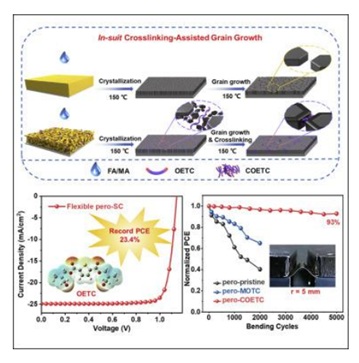In situ crosslinking-assisted perovskite grain growth for mechanically robust flexible perovskite solar cells with 23.4% efficiency
Yeyong Wu1 ,5, Guiying Xu1 ,5, Jiachen Xi1, Yunxiu Shen1, Xiaoxiao Wu1, Xiaohua Tang1, Junyuan Ding1, Heyi Yang1, Qinrong Cheng1, Ziyuan Chen1, Yaowen Li1, 2, 3, 6,* (李耀文), Yongfang Li1 ,2, 4
1Laboratory of Advanced Optoelectronic Materials, Suzhou Key Laboratory of Novel Semiconductor-optoelectronics Materials and Devices, College of Chemistry, Chemical Engineering and Materials Science, Soochow University, Suzhou 215123, China
2Jiangsu Key Laboratory of Advanced Negative Carbon Technologies, Soochow University, Suzhou 215123, Jiangsu, China
3State and Local Joint Engineering Laboratory for Novel Functional Polymeric Materials, Jiangsu Key Laboratory of Advanced Functional Polymer Design and Application, College of Chemistry, Chemical Engineering and Materials Science, Soochow University, Suzhou 215123, China
4Beijing National Laboratory for Molecular Sciences, CAS Key Laboratory of Organic Solids, Institute of Chemistry, Chinese Academy of Sciences, Beijing 100190, China
5These authors contributed equally
6Lead contact
Joule, 2023, 7, 398-415
Flexible perovskite solar cells (pero-SCs) are the best candidates to complement silicon solar cells in the photovoltaic market. However, their power conversion efficiencies (PCEs) and mechanical stability are far behind the industry standards because of the uncontrollable growth of perovskites on plastic substrates and intrinsically high Young’s modulus. We explored an in situ crosslinking bis((3-methyloxetan-3-yl) methyl) thiophene-2,5-dicarboxylate along with perovskite growth, and its coordination ability and crosslinking temperature enabled the fine regulation of the quality of perovskite in real time. The resultant perovskite film exhibits an enlarged grain size, compact stacking, and a preferential crystal orientation. Moreover, the crosslinked elastomer polymer gathered at the perovskite grain boundaries can effectively release the mechanical stress. As a result, the flexible pero-SC based on this perovskite film achieved a record PCE of 23.4% (certified 22.9%), which is comparable with that of the rigid device. Importantly, the flexible pero-SCs also display a robust bending durability.

链接://www.sciencedirect.com/science/article/pii/S2542435122006122